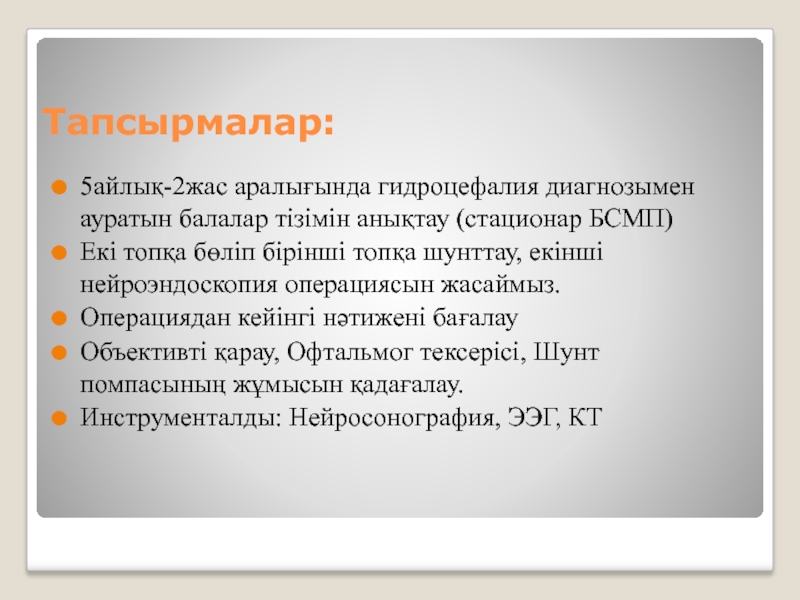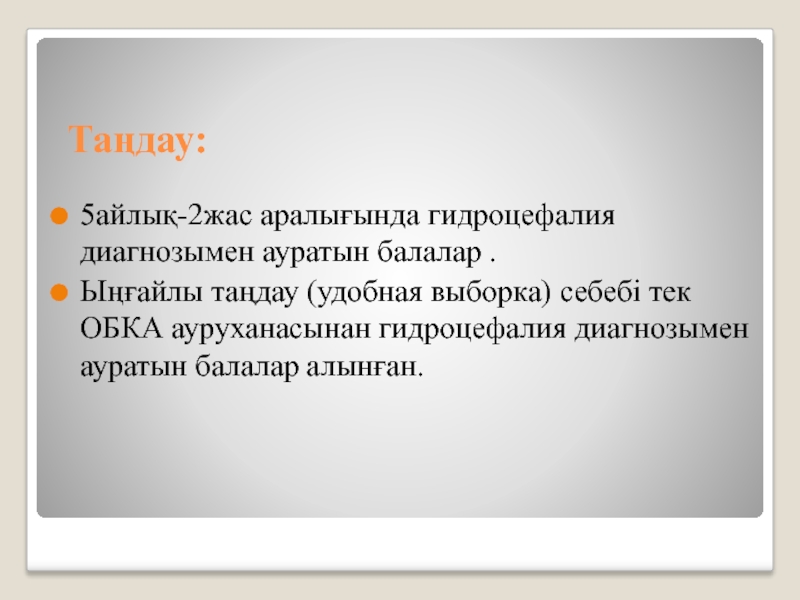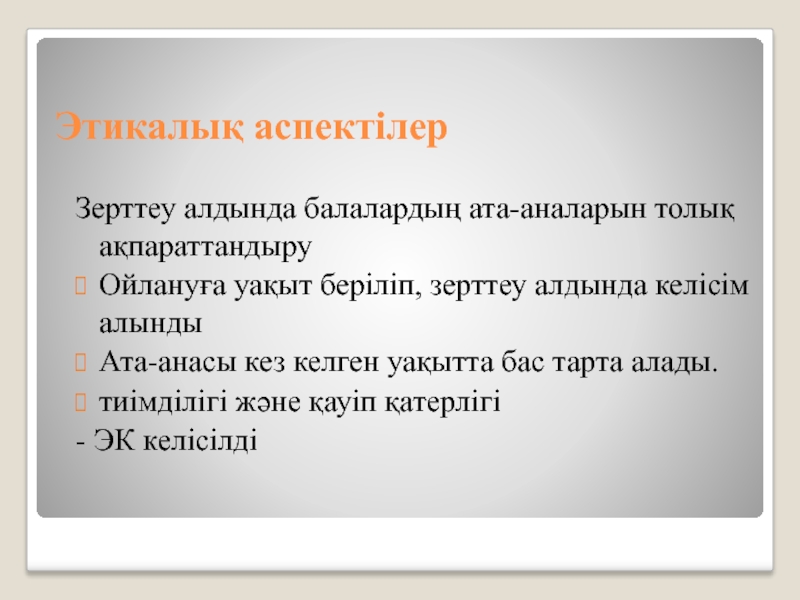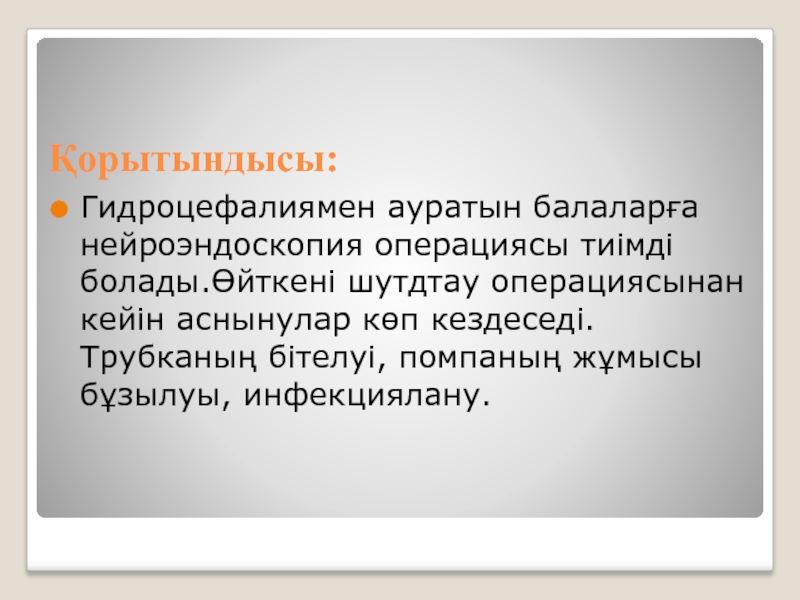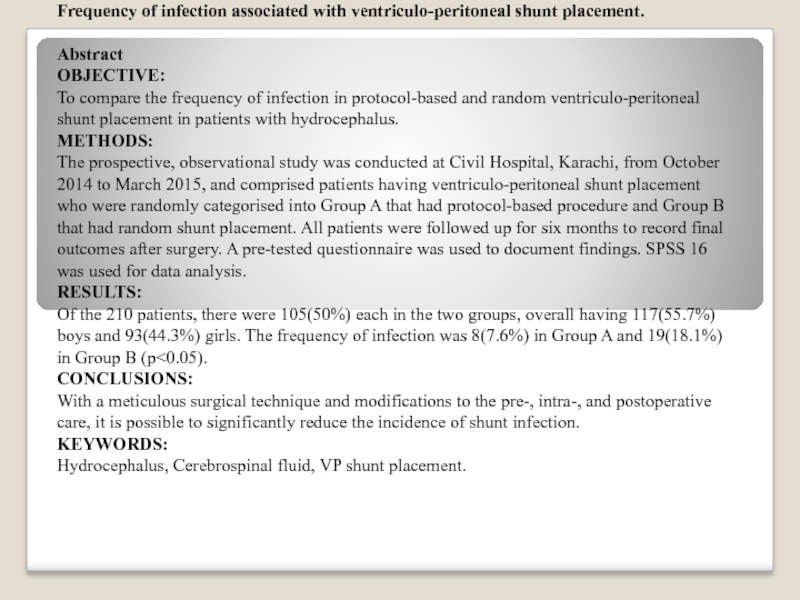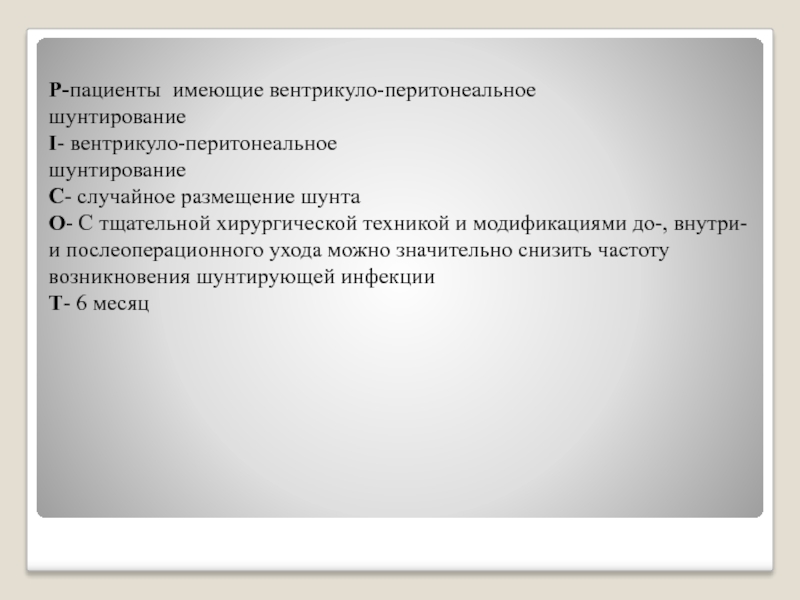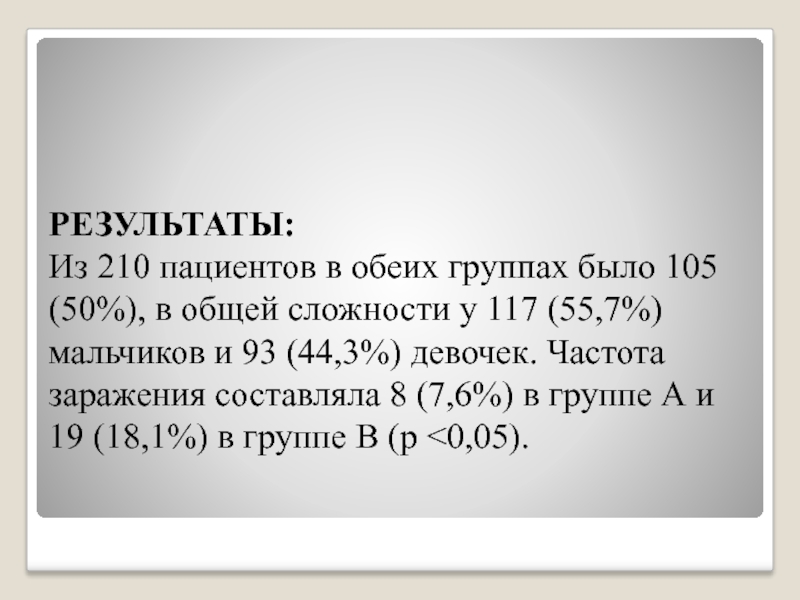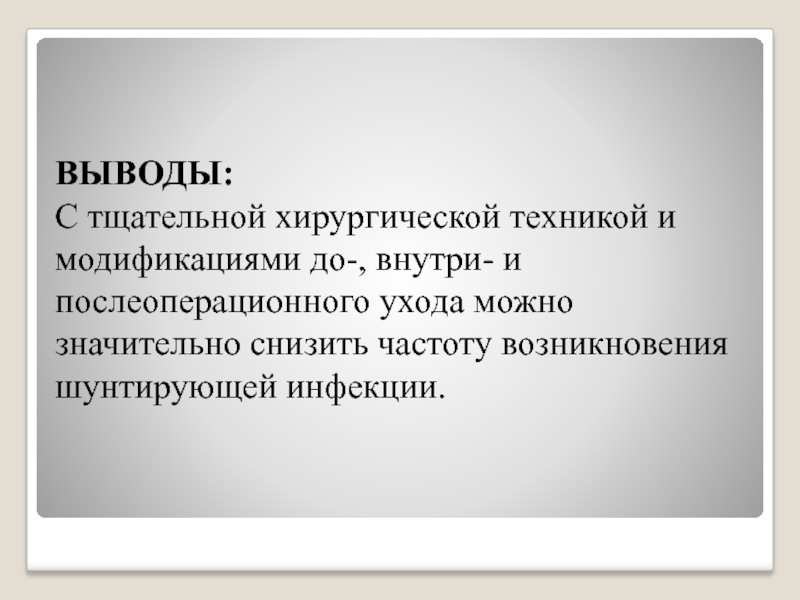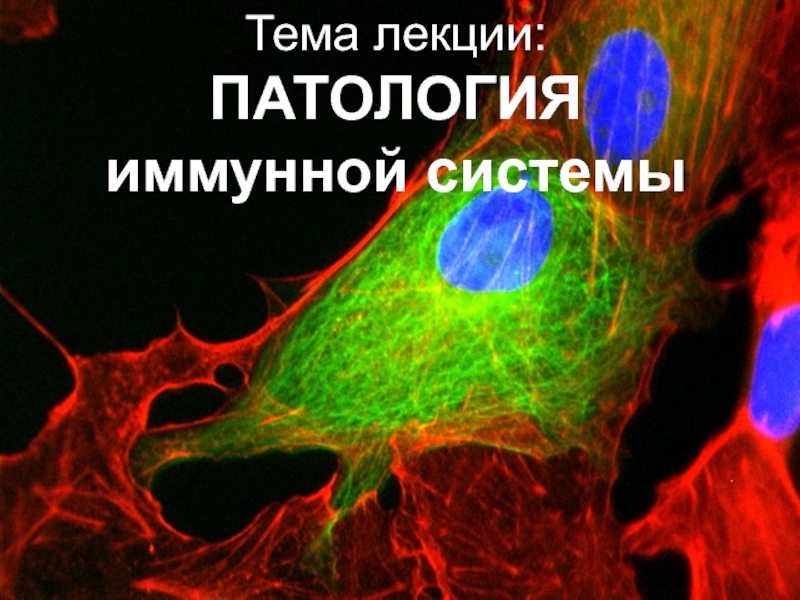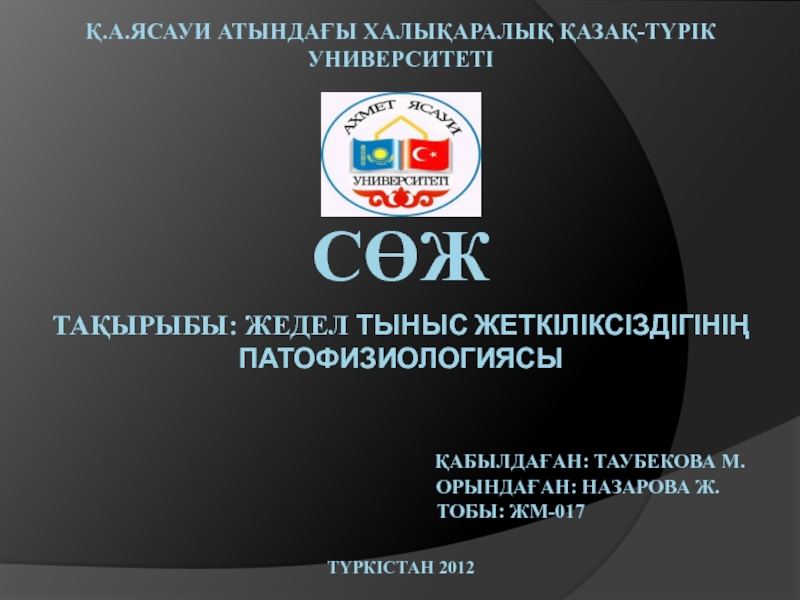Орындаған: Мукашев Д.Н
- Главная
- Разное
- Дизайн
- Бизнес и предпринимательство
- Аналитика
- Образование
- Развлечения
- Красота и здоровье
- Финансы
- Государство
- Путешествия
- Спорт
- Недвижимость
- Армия
- Графика
- Культурология
- Еда и кулинария
- Лингвистика
- Английский язык
- Астрономия
- Алгебра
- Биология
- География
- Детские презентации
- Информатика
- История
- Литература
- Маркетинг
- Математика
- Медицина
- Менеджмент
- Музыка
- МХК
- Немецкий язык
- ОБЖ
- Обществознание
- Окружающий мир
- Педагогика
- Русский язык
- Технология
- Физика
- Философия
- Химия
- Шаблоны, картинки для презентаций
- Экология
- Экономика
- Юриспруденция
5айлық-2жас аралығында гидроцефалия диагнозымен ауратын балаларға жасалынатын шунттау операциясына қарағанда нейроэндоскопия презентация
Содержание
- 1. 5айлық-2жас аралығында гидроцефалия диагнозымен ауратын балаларға жасалынатын шунттау операциясына қарағанда нейроэндоскопия
- 2. Сұрақ: 5айлық-2жас аралығында гидроцефалия диагнозымен
- 3. Мақсаты: 5айлық-2жас аралығында гидроцефалия диагнозымен
- 4. P- (5айлық-2жас аралығында гидроцефалия диагнозымен ауратын балалар
- 5. Тапсырмалар: 5айлық-2жас аралығында гидроцефалия диагнозымен
- 6. Зерттеу Дизайны Экспериментальды Бақыланатын (контролируемые) Рандомизирленген Ашық зерттеу
- 7. Таңдау: 5айлық-2жас аралығында гидроцефалия диагнозымен ауратын балалар
- 8. Этикалық аспектілер Зерттеу алдында балалардың ата-аналарын толық
- 9. Қорытындысы: Гидроцефалиямен ауратын балаларға нейроэндоскопия операциясы тиімді
- 10. Frequency of infection
- 11. Дизайн -Экспериментальный -Контролируемые -РКИ -Открытое
- 12. ЦЕЛЬ: Чтобы сравнить частоту инфицирования на основе
- 13. Р-пациенты имеющие вентрикуло-перитонеальное шунтирование І- вентрикуло-перитонеальное
- 14. Задачи: -группу А, в которой была процедура
- 15. РЕЗУЛЬТАТЫ: Из 210 пациентов в обеих группах
- 16. ВЫВОДЫ: С тщательной хирургической техникой и модификациями
Слайд 1Тақырыбы: 5айлық-2жас аралығында гидроцефалия диагнозымен ауратын балаларға жасалынатын шунттау операциясынан нейроэндоскопия
операциясының тиімділігі
Слайд 2 Сұрақ: 5айлық-2жас аралығында гидроцефалия диагнозымен ауратын балаларға жасалынатын шунттау
операциясына қарағанда нейроэндоскопия операциясының тиімділігін анықтауға бола ма?
Слайд 3 Мақсаты: 5айлық-2жас аралығында гидроцефалия диагнозымен ауратын балаларға жасалынатын шунттау
операциясынан нейроэндоскопия операциясының тиімділігін анықтау
Слайд 4P- (5айлық-2жас аралығында гидроцефалия диагнозымен ауратын балалар ). I- Шунттау операциясы
C-Нейроэндоскопия.
O-Нейроэндоскопия операциясы тиімді
T-3 жыл.
Слайд 5
Тапсырмалар:
5айлық-2жас аралығында гидроцефалия диагнозымен ауратын балалар тізімін анықтау (стационар БСМП)
Екі топқа
бөліп бірінші топқа шунттау, екінші нейроэндоскопия операциясын жасаймыз.
Операциядан кейінгі нәтижені бағалау
Объективті қарау, Офтальмог тексерісі, Шунт помпасының жұмысын қадағалау.
Инструменталды: Нейросонография, ЭЭГ, КТ
Операциядан кейінгі нәтижені бағалау
Объективті қарау, Офтальмог тексерісі, Шунт помпасының жұмысын қадағалау.
Инструменталды: Нейросонография, ЭЭГ, КТ
Слайд 7Таңдау:
5айлық-2жас аралығында гидроцефалия диагнозымен ауратын балалар .
Ыңғайлы таңдау (удобная выборка) себебі
тек ОБКА ауруханасынан гидроцефалия диагнозымен ауратын балалар алынған.
Слайд 8Этикалық аспектілер
Зерттеу алдында балалардың ата-аналарын толық ақпараттандыру
Ойлануға уақыт беріліп, зерттеу алдында
келісім алынды
Ата-анасы кез келген уақытта бас тарта алады.
тиімділігі және қауіп қатерлігі
- ЭК келісілді
Ата-анасы кез келген уақытта бас тарта алады.
тиімділігі және қауіп қатерлігі
- ЭК келісілді
Слайд 9Қорытындысы:
Гидроцефалиямен ауратын балаларға нейроэндоскопия операциясы тиімді болады.Өйткені шутдтау операциясынан кейін аснынулар
көп кездеседі. Трубканың бітелуі, помпаның жұмысы бұзылуы, инфекциялану.
Слайд 10 Frequency of infection associated with ventriculo-peritoneal shunt placement. Abstract OBJECTIVE: To compare the frequency
of infection in protocol-based and random ventriculo-peritoneal shunt placement in patients with hydrocephalus.
METHODS:
The prospective, observational study was conducted at Civil Hospital, Karachi, from October 2014 to March 2015, and comprised patients having ventriculo-peritoneal shunt placement who were randomly categorised into Group A that had protocol-based procedure and Group B that had random shunt placement. All patients were followed up for six months to record final outcomes after surgery. A pre-tested questionnaire was used to document findings. SPSS 16 was used for data analysis.
RESULTS:
Of the 210 patients, there were 105(50%) each in the two groups, overall having 117(55.7%) boys and 93(44.3%) girls. The frequency of infection was 8(7.6%) in Group A and 19(18.1%) in Group B (p<0.05).
CONCLUSIONS:
With a meticulous surgical technique and modifications to the pre-, intra-, and postoperative care, it is possible to significantly reduce the incidence of shunt infection.
KEYWORDS:
Hydrocephalus, Cerebrospinal fluid, VP shunt placement.
Слайд 12ЦЕЛЬ: Чтобы сравнить частоту инфицирования на основе протокола и случайного вентрикуло-перитонеального шунта
у пациентов с гидроцефалией .
Слайд 13Р-пациенты имеющие вентрикуло-перитонеальное шунтирование І- вентрикуло-перитонеальное шунтирование С- случайное размещение шунта О- С тщательной
хирургической техникой и модификациями до-, внутри- и послеоперационного ухода можно значительно снизить частоту возникновения шунтирующей инфекции
Т- 6 месяц
Слайд 14Задачи: -группу А, в которой была процедура на основе протокола -группа В, в
которой было случайное размещение шунта
- фиксировать конечные результаты после операции
Слайд 15РЕЗУЛЬТАТЫ: Из 210 пациентов в обеих группах было 105 (50%), в общей
сложности у 117 (55,7%) мальчиков и 93 (44,3%) девочек. Частота заражения составляла 8 (7,6%) в группе А и 19 (18,1%) в группе В (р <0,05).
Слайд 16ВЫВОДЫ: С тщательной хирургической техникой и модификациями до-, внутри- и послеоперационного ухода
можно значительно снизить частоту возникновения шунтирующей инфекции.




